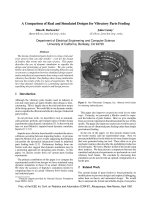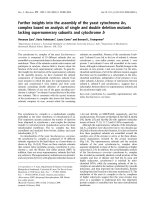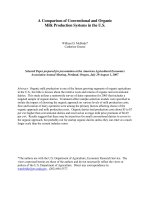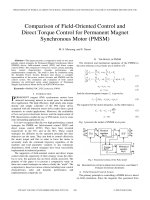- Trang chủ >>
- Khoa Học Tự Nhiên >>
- Vật lý
comparison of single and binary oxide moo3, tio2 and wo3 sol – gel gas sensors
Bạn đang xem bản rút gọn của tài liệu. Xem và tải ngay bản đầy đủ của tài liệu tại đây (295.5 KB, 5 trang )
Comparison of single and binary oxide MoO
3
,TiO
2
and WO
3
sol±gel gas sensors
K. Galatsis
a,b,*
, Y.X. Li
a,c
, W. Wlodarski
d
, E. Comini
d
, G. Sberveglieri
d
,
C. Cantalini
e
, S. Santucci
f
, M. Passacantando
f
a
Sensor Technology Laboratory, School of Electrical and Computer Engineering, RMIT, G.P.O. Box 2476V, Melbourne 3001, Australia
b
CRC for Microtechnology, P.O. Box 214, Hawthorn, VIC 3122, Australia
c
Laboratory of Inorganic Functional Materials, SICCAS, Shanghai 20005, PR China
d
Dipartimento di Chimica e Fisica per I Materiali e INFM, Universita di Brescia, Via Valotti 9, I-25133 Brescia, Italy
e
Department of Chemistry and Materials, University of L'Aquila, 67040 L'Aquila, Italy
f
Department of Physics, University of L'Aquila, 67010 Coppito, L'Aquila, Italy
Abstract
A systematic comparison of sol±gel prepared titanium dioxide (TiO
2
), WO
3
, and MoO
3
single metal oxide based gas sensors was conducted.
Process variables such as solution concentration, deposition parameters, gelling time, annealing time and temperature, remained constant.
Sensors based on binary compound MoO
3
±TiO
2
and MoO
3
±WO
3
were also investigated to determine if the performance is superior to their
single oxide constituents. The sensors were systematically exposed to O
2
,O
3
, CO and NO
2
gases and ethanol vapor at concentration levels of
particular interest. MoO
3
binary compound based sensors showed promising O
3
, CO and NO
2
gas response. Their use as a sensing ®lm for gas is
limited due to the materials low evaporating temperature, limiting its operating temperature below 350 8C. However, the binary oxide of MoO
3
±
WO
3
showed a high response to ethanol vapor and a highly selective response to NO
2
. # 2002 Elsevier Science B.V. All rights reserved.
Keywords: Gas sensors; Titanium oxide; Tungsten oxide; Molybdenum oxide
1. Introduction
A variety of techniques are available for fabricating thin
®lms of metal oxide semiconducting (MOS) materials.
Popular techniques are sputtering, chemical vapor, thermal
or electronic beam evaporation deposition. Sol±gel thin
®lm fabrication is a simple and versatile method of realising
metal oxide thin ®lms. Many research efforts are progres-
sively employing this technology to explore new and novel
sensing materials for gas sensing applications, as it is a
low cost alternative, ®nancially bene®cial as compared to
maintaining physical vapor deposition or chemical vapor
deposition (PVD±CVD) equipment and purchasing high-cost
targets.
By standardizing many thin ®lm fabrication variables in
the sol±gel process, such as solution concentration, deposi-
tion parameters, gelling time, annealing time and tempera-
ture, operating temperature and transducers employed; a
systematic comparison of single metal oxides of titanium
dioxide (TiO
2
), WO
3
and MoO
3
has been undertaken.
2. Background
TiO
2
,WO
3
and MoO
3
single metal oxide compound
materials have been extensively studied in the past decade.
They show promising gas sensing properties as well as
unique optical properties for various applications. However,
as in most cases, practical and high performance MOS based
gas sensors are seldom made up of pure single metal oxides.
Catalysts are usually deposited to increase the chemisorp-
tion process and instigate fast response as well as high
sensitivity and improved selectivity. Nevertheless, a com-
plete understanding of any single metal oxide constituting
within a material composition is required.
TiO
2
is commonly used in many devices such as solar
cells, optical wave guides, interference ®lters, capacitors and
as a popular material in the MOS gas sensor domain. In
its rutile phase (tetragonal), stable at temperatures above
800 8C, it is employed as an oxygen gas sensor (bulk defect
sensors) for automotive air:fuel ratio control (lambda sen-
sors). Such sensors have been commercialized by NGK
Spark Plug Co. Ltd. [1]. Compared to the traditional lambda
sensors based on ZrO
2
,TiO
2
thick ®lm sensors offer a faster
response time [2]. TiO
2
gas sensors operating at tempera-
tures below 600 8C, make use of the anatase phase that has a
Sensors and Actuators B 83 (2002) 276±280
*
Corresponding author. Tel.: 61-3-9925-3690; fax: 61-3-9925-2007.
E-mail address: (K. Galatsis).
0925-4005/02/$ ± see front matter # 2002 Elsevier Science B.V. All rights reserved.
PII: S 0925-4005(01)01072-3
lower resistance and higher sensitivity to surface adsorbents
than that of the rutile phase [3]. In this case, the sensing
mechanism is dominated by chemisorption where oxygen
captures electrons from the oxide, producing a depletion
region (space-charge layer) near the surface. With respect to
gas sensing, anatase TiO
2
nanocrystalline thin ®lms are
preferred since they exhibit desirable gas sensing character-
istics at operating temperature below 400 8C.
Tungsten trioxide (WO
3
) ®lms are reported to have
promising electrical and optical properties for various appli-
cations like ef®cient photolysis, electrochromic devices,
selective catalysts and gas sensors [4]. Amorphous and
polycrystalline WO
3
®lms are particularly attractive as
gas sensors because they show a high catalytic behavior
both in oxidation and reduction reactions [5]. Electrochro-
mic devices which exploit WO
3
are typically in an amor-
phous form, whereas electrical devices such as gas sensors,
are in a crystalline form [6]. Tungsten also forms other
oxides such as WO, W
2
O
3
, and W
4
O
3
, however, in gas
sensing the stable WO
3
form is used.
As for MoO
3
, it exhibits two problems for gas sensing.
First, the material has a low evaporating temperature, per-
mitting only low operating temperatures, however, such
temperatures may not indeed be the optimal working tem-
perature for particular gas species. The melting point of
MoO
3
is 795 8C, relatively low compared to SnO
2
at
1127 8C. Second, the material has a very high resistivity,
making it a dif®cult material to realize as a gas sensor and to
integrate with electronics. Although, these two disadvan-
tages have been identi®ed, MoO
3
possesses good gas
response since it has been used in the ®eld of catalysis
for oxidation reactions of hydrocarbons [7]. MoO
3
has a
bandgap of 3.2 eV and electrical resistivity at room tem-
perature is of the order of 10
10
O cm.
Multi-metal oxide compound materials for gas sensing
applications has been an important focus recently in the
MOS gas sensing ®eld. Many oxide combinations can be
tailored to achieve desired surface to volume ratios and
morphologies as to attain various gas sensing performance.
The addition of a second element may cause a decrease in
the grain size, which in addition improves gas sensor
response characteristics. Current research of binary-metal
oxide ®lms is extremely promising but still at an initial
stage. By varying the composition of the binary-metal oxide
material, the sensor performance can be modi®ed, i.e.
improve selectivity, reduce detection limit, fabricating n-
or p-type material and modifying the material resistivity for
ease of electronic interface. Recent studies focusing on Mo,
Wand Ti based mixed metal oxides report on their promising
gas sensing potential [8±10].
3. Experimental
TiO
2
,WO
3
, MoO
3
, MoO
3
±TiO
2
and MoO
3
±WO
3
were
prepared by the sol±gel method. The precursors used to
fabricate the solutions are shown in Table 1. The solutions
were prepared as described in [8,9]. The solutions was spun
onto alumina and sapphire conductometric structured sub-
strates incorporating interdigital electrode ®ngers on the
front side and an integrated heater on the backside. All
the ®lms were annealed at 450 8C for 1 h.
4. Results and discussion
4.1. SEM analysis
It is well known that gas sensing properties of a metal
oxide thin ®lm strongly depends on its morphological
features. A high surface area facilitates the chemisorption
process by increasing the adsorption and desorption rates
[11]. The grain, neck and grain boundary features also
in¯uences the gas sensing properties.
It has been shown that the smaller grain size increases gas
sensitivity since the diameter is comparable with or less than
the space-charge region of the grain [12]. Additionally, for
high value of relative conductance change (high response) it
is necessary to have a low density of bulk carriers, n
b
, and a
thin ®lm thickness, d, [13]. The microstructure and the
surface morphology of the ®lms were examined using a
scanning electron microscope (SEM, Philips XL-30). As
shown from Fig. 1, the morphology of TiO
2
,WO
3
, and
MoO
3
is dramatically different. TiO
2
and WO
3
are made up
of spherical grain structures. However, MoO
3
is made up of
long needle like particles growing up from the ®lm. Such
®lm morphology clearly does not facilitate ®lm electron
¯ow. The binary oxides of MoO
3
±TiO
2
and MoO
3
±WO
3
are
a composite of both their single metal oxide constituents.
Fig. 1e shows that the segregated grown up MoO
3
particles,
as also detected by EDX analysis, disperses into a re®ned
mixed multi oxide based structure as the W content of the
®lm increases with respect to the Mo content.
The gas sensing properties of TiO
2
,WO
3
and MoO
3
single
metal oxide compounds were examined when exposed to O
2
,
O
3
, CO, NO
2
gases and ethanol vapor.
4.2. Oxygen (O
2
) gas sensing
Table 2 summarizes the O
2
response results. TiO
2
, and
MoO
3
exhibit high oxygen responses compared to WO
3
.As
was expected, the sol±gel TiO
2
sensor exhibited a superior
O
2
response, relatively fast and consistently returning to its
baseline as seen from Fig. 1.
Table 1
Sol±gel precursors
Component Chemicals Formula
Mo precursor Molybdenum iso-propoxide Mo(OC
3
H
7
)
5
Ti precursor Titanium butoxide Ti(OC
4
H
9
)
4
W precursor Tungsten ethoxide W(OC
2
H
5
)
6
K. Galatsis et al. / Sensors and Actuators B 83 (2002) 276±280 277
4.3. Ozone (O
3
) gas sensing
It is well known that both In
2
O
3
[14] and WO
3
[15] are
highly sensitive to O
3
. Sol±gel based WO
3
has a response of
35±80 ppb of O
3
[15]. Sol±gel based MoO
3
±WO
3
was
compared to commercially available In
2
O
3
based sensors
(New Cosmos Electric Co. Ltd.). TiO
2
did not show a
measurable response to ozone gas. MoO
3
response to O
3
could not be measured due to a high resistance. Therefore, to
measure the MoO
3
ozone response, MoO
3
±TiO
2
and MoO
3
±
WO
3
were fabricated which reduced the ®lms resistivity.
Most interesting was MoO
3
±TiO
2
with a response time less
than 20 s to 100 ppb of O
3
and a response of 1.7. The
response is also very stable for ozone, while the recovery
time is sluggish at about 2 min. MoO
3
±WO
3
exhibits pro-
mising results to O
3
as shown in Figs. 2 and 3. Hence, MoO
3
based sensors could be considered as promising candidates
for O
3
gas sensing.
Fig. 1. Morphological difference of (a) TiO
2
; (b) MoO
3
; (c) WO
3
;
(d) MoO
3
±TiO
2
; (e) MoO
3
±WO
3
on Si substrates annealed at 450 8C.
Table 2
Response to 1000 ppm of O
2
Sensor (t
res 0.9
)(t
rec 0.3
) Response Temperature (8C)
MoO
3
1539370
WO
3
4 4 7.5 420
TiO
2
2 1.5 28 420
Fig. 2. Oxygen dynamic response of TiO
2
and MoO
3
sensors operating at
370 8C.
Fig. 3. Dynamic response MoO
3
±WO
3
(T 150 8C) compared to the
superior In
2
O
3
(Cosmos) ozone sensor.
278 K. Galatsis et al. / Sensors and Actuators B 83 (2002) 276±280
4.4. Carbon monoxide (CO) and nitrogen
dioxide (NO
2
) gas sensing
TiO
2
had a negligible response to CO compared with
WO
3
and MoO
3
. MoO
3
and WO
3
showed promising CO and
NO
2
results. MoO
3
exhibited a high response to both CO and
NO
2
as shown in Fig. 4.
The binary system of MoO
3
±TiO
2
was fabricated so that
the resistance of MoO
3
would decrease. The material
attained its high response to CO, however, it was not as
responsive to NO
2
as compared to pure MoO
3
. MoO
3
±WO
3
surprisingly did not respond to CO and was selective only to
NO
2
, i.e. having a response of 2.3 and a time response of 60 s
to 1 ppm of NO
2
as shown in Fig. 5.
4.5. Ethanol vapor sensing
The sensors where exposed to 100±600 ppm of ethanol
and to 10±30 ppm of CO to investigate the cross-sensitivity
effects. CO is a typical nuisance gas commonly experienced
by law enforcement bodies in the ®eld of random breath
testing as it is emitted from vehicle exhausts and cigarettes.
All oxide compounds exhibited good gas sensing perfor-
mance to ethanol.
MoO
3
had the best response compared to the single metal
oxides. Furthermore, the mixed oxide of MoO
3
±WO
3
exhib-
ited an exceptional response to ethanol trading off response
time and stability as shown in Fig. 6.
Table 3 shows the response comparison of the three
sensors tested, made up of different materials. The mixed
metal oxide MoO
3
±WO
3
outperforms both single metal
oxides in response, improving by 380 and 750% of pure
MoO
3
and WO
3
based sensors, respectively. WO
3
has a
negligible response to CO, which is desirable. Furthermore,
commercialized alcohol sensors [16] have a response of 10±
500 ppm (0.05%) of ethanol.
Fig. 4. CO and NO
2
response of Mo and W oxide sensors operating at
300 8C.
Fig. 5. The dynamic response of a MoO
3
±WO
3
film to CO and NO
2
.
Fig. 6. Response to 100 and 600 ppm of ethanol at an operational
temperature of 300 8C.
K. Galatsis et al. / Sensors and Actuators B 83 (2002) 276±280 279
5. Conclusions
MoO
3
based sensors showed promising O
3
gas sensing
characteristics. MoO
3
±TiO
2
showed a good response to CO,
outperforming other single metal oxides tested. Interestingly,
MoO
3
±WO
3
exhibited a high selectivity to NO
2
,i.e.having
an undetectable response to 30 ppm of CO. The binary sys-
tems of MoO
3
±WO
3
also showed a high response to ethanol
vapor outperforming the single metal oxides. MoO
3
has to be
highly oxidized and reduced. By mixing it with TiO
2
and
WO
3
, the resistivity is reduced and in cases of O
3
,COand
NO
2
gas and ethanol vapor sensing, its performance is
enhanced.
Acknowledgements
The authors are grateful to Dr. Tadashi Takada from
New Cosmos Electric Co. Ltd. (Japan) for providing ozone
sensors for comparative purposes. The work was partially
supported by the Co-operative Research Center for Micro-
technology, Australia, the project title ``High Performance
Gas Sensing Films''.
References
[1] S. Matsuura, New developments and applications of gas sensors in
Japan, Sens. Actuators B 13/14 (1993) 7±11.
[2] E.M. Logothetis, Automotive oxygen sensors, in: N. Yamazoe (Ed.),
Chemical Sensor Technology, Vol. 3, Elsevier, Amsterdam, 1991.
[3] F. Edelman, et al, Nanophase crystallisation in TiO
2
thin films for gas
sensors, in: Proceedings of the 11th European Conference on Solid-
State Transducers, Poland, September 1997.
[4] H.T. Sun, C. Cantalini et al., Microstructural effect on NO
2
sensitivity of WO
3
thin film gas sensors. Part 1. Thin film devices,
sensors and actuators, Thin Solid Films 287 (1996) 258±265.
[5] H.H. Kung, Transition Metal Oxides: Surface Chemistry and
Catalysis, Elsevier, NY, 1989.
[6] A. Takase, K. Miyakawa, Raman study on sol±gel derived tungsten
oxides from tungsten ethoxide, Jpn. J. Appl. Phys. 30 (8) (1991)
1508±1511.
[7] J.C. Volta, Structural-sensitive catalaytic oxidation on MoO
3
catalysts, in: Proceedings of the 8th International Conference on
Catalysts, July 1984.
[8] K. Galatsis, Y.X. Li, W. Wlodarski, E. Comini, G. Faglia, G.
Sberveglieri, Semiconductor MoO
3
±TiO
2
thin film gas sensor, Sens.
Actuators B 77 (2001) 474±477.
[9] K. Galatsis, Y.X. Li, W. Wlodarski, Sol±gel prepared MoO
3
±WO
3
thin films for gas sensing, Sens. Actuators B 77 (2001) 478±483.
[10] Y.X. Li, K. Galatsis, W. Wlodarski, M.K. Ghantasala, S. Russo,
J. Gorman, et.al., Microstructure characterization of MoO
3
±TiO
2
nanocomposite thin films for gas sensing, Sens. Actuators B 77
(2001) 27±34.
[11] L.Y. Kupriyanov, Semiconductor Sensors in Physico-Chemical
Studies, Elsevier, Amsterdam, 1996.
[12] N. Yamazoe, N. Miura, Some basic aspects of semiconductor gas
sensors, in: S. Yamauchi (Ed.), Chemical Sensor Technology, Vol. 4,
Elsevier, Amsterdam, 1992.
[13] P.T. Moseley, D.E. Williams, Principles of Chemical Sensors,
Plenum, New York, 1989.
[14] T. Takada, Ozone detection by In
2
O
3
thin films gas sensor, in: T.
Seiyama (Ed.), Chemical Sensor Technology, Vol. 2, Elsevier,
Amsterdam, 1989.
[15] C. Cantalini, W. Wlodarski, Investigation on the O
3
sensitivity
properties of WO
3
thin films prepared by sol±gel, thermal
evaporation and r.f. sputtering techniques, Sens. Actuators B 64
(2000) 182±188.
[16] Capteur Sensors and Analysers Ltd., Capteur SensorsÐGas Sensor
Air Quality SolutionsÐHelping to Make the Air Safer and Cleaner.
[WWW Document], , 2000.
Biographies
K. Galatsis received his degree with honours in computer systems
engineering from the Royal Melbourne Institute of Technology University,
Australia, in 1998. His research efforts focus on MoO
3
based MOS gas
sensors, gas analyzers, vehicle cabin air quality, and smoke-dust IR
backscatter detectors.
Y.X. Li received his PhD degree in electronics engineering from Xi'an
Jiaotong University in 1991. He is now a research fellow at Shanghai
Institute of Ceramics (SICCAS) and RMIT University, Australia. His
research interests are nanocomposites, electronic ceramics, thin solid films
for electochromism, and chemical sensors. He has more than 60 papers and
4 Patents covered in these fields.
W. Wlodarski has worked in the areas of sensor technology and
instrumentation for over 30 years. He has published four books and
monographs and over 200 papers and holds 26 Patents. He is a Professor at
RMIT University, Melbourne, Australia and heads the Sensor Technology
Laboratory located in the School of Electrical and Computer Systems
Engineering.
Table 3
Ethanol and CO response magnitude comparison
Sensor Ethanol
(100 ppm)
Ethanol
(600 ppm)
CO
(10 ppm)
CO
(30 ppm)
MoO
3
6.7 14.0 1.05 1.25
MoO
3
±WO
3
10.0 53.0 1.0 1.0
WO
3
2.5 7.0 1.0 1.0
280 K. Galatsis et al. / Sensors and Actuators B 83 (2002) 276±280









